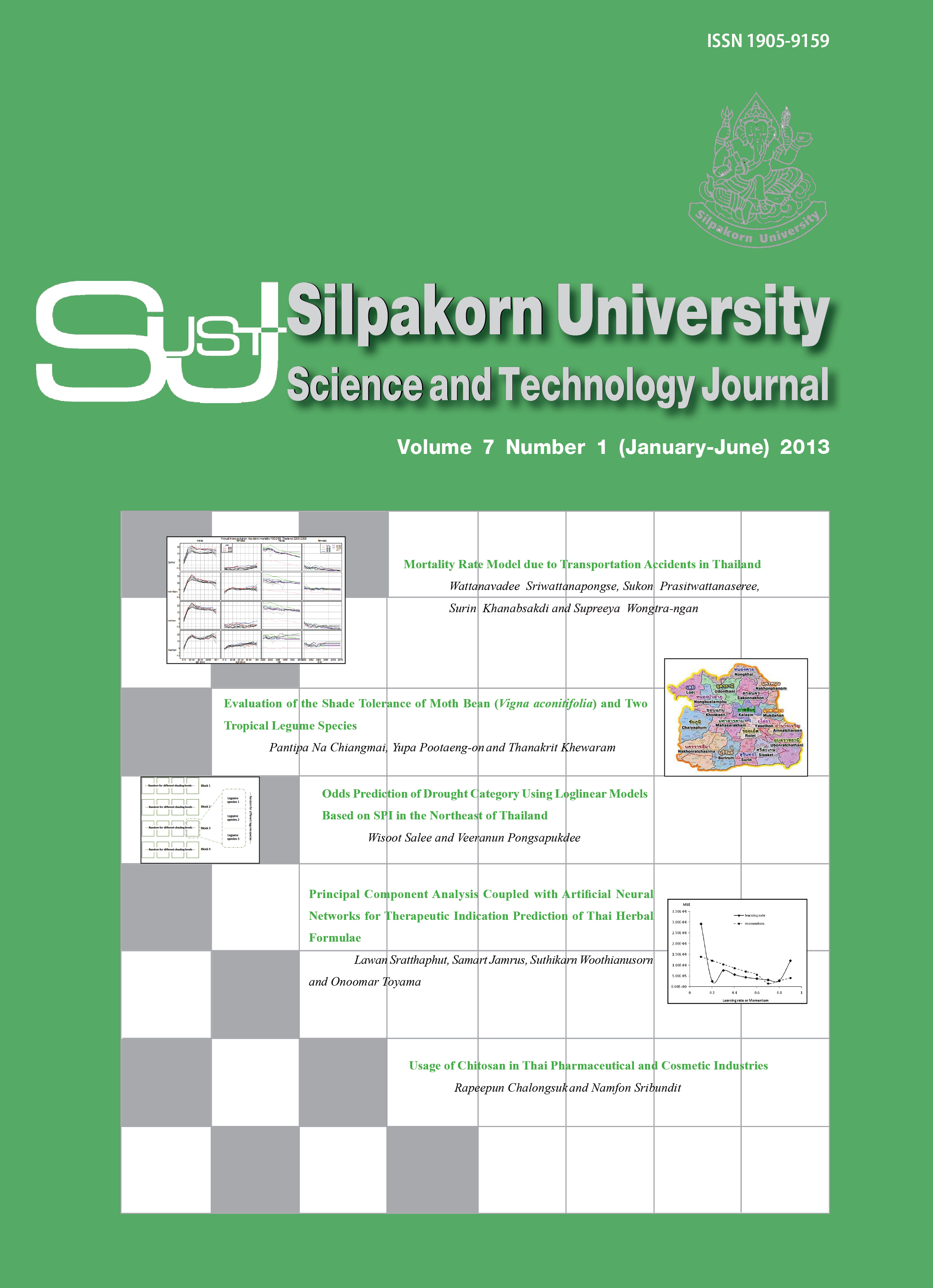Odds Prediction of Drought Category Using Loglinear Models Based on SPI in the Northeast of Thailand
Main Article Content
Abstract
The prediction of drought category is performed through Loglinear modeling for three dimensional contingency tables. The frequencies of drought categories are evaluated from a 12-month time scale by means of Standardized Precipitation Index (SPI), using the raw data obtained from 19 rain gauge stations in 19 provinces in the Northeast of Thailand. SPI monthly values were computed in a 12 month time scale for the period from January 1962 to December 2009, within 48 years or 576 months in each of 19 rainfall stations. The results show that the selected quasi-association loglinear model is an adequate model and appropriate tool to fit the data from 19 stations (P-value = 0.927). The values of various drought class transitions are estimated in three consecutive months. The predicted odds ratios and the corresponding confidence intervals are evaluated to predict the drought classes’ transitions. Even if, most of the results display for more normal drought classes than those of moderate or severity drought classes; however, there are still some areas of investigation that drought could be developed. Therefore, future monitoring of drought watch system is needed to be set the pace in these areas to keep up with them. Furthermore, an appropriate statistical model to predict drought phenomenon in each area is necessary and is probably able to provide more effectiveness in the administrative management of hazard from drought.
Downloads
Article Details
References
Agresti, A. (2002). Categorical Data Analysis. 2nd ed., John Wiley & Sons, New York.
Fienberg, S. E. (2000). Contingency Tables and Log-Linear Models: Basic Results and New Developments. Journal of the American Statistical Association, 95: 643-647.
Moreira Elsa E., Ana A. Paulo, Luis S. Pereira, and Joao T. Mexia. (2006). Analysis of SPI drought class transitions using loglinear models. Journal of the Science Direct, 331: 349-359.
Moreira Elsa E., Carlos A. Coelho, Ana A. Paulo, Luis S. Pereira, and Joao T. Mexia. (2008). SPI-based drought category prediction using loglinear models. Journal of the Science Direct, 354: 116-130.
Mckee, T. B., Doesken, N. J., and Kleist, J. (1993). The relationship of drought frequency and duration to time scales. In Proceedings of the Eighth Conference on Applied Climatolgy. American Meteorological Society. Boston: 233-236.
Nelder, J. A. (1974). Loglinear models for contingency tables: a generalization of classical least squares. Applied Statistics. John Wiley & Sons, New York.
Nebraska-Lincoin University. “SPI.” [Online URL: www.drought.unl.edu] accessed on July 10, 2009.
Paulo, A. A., Ferreira, E., Coelho, C., and Pereira, L. S. (2005). Drought class transition analysis through Markov and Loglinear models, an approach to early warning. Agricultural Water Management, 77:59-81.
Paulo, A. A. and Pereira, L. S. (2006b). Prediction of SPI drought class transitions using Markov chains. Water International 31 (in press).
Paulo, A. A., Pereira, L. S., and Matias, P. G. (2003). Analysis of local and regional droughts in southern Portugal using the theory of runs and the Standardized. Water International, 28: 65-68.
Pereira, L. S., Cordery, I., and Iacovides, I. (2002). Coping with Water Scarcity. UNESCO IHP VI, Technical Documents in Hydrology No. 58, UNESCO, Paris, 267 pp. [Online URL: www.unescdoc.unesco.org/images/0012/001278/127846.pdf].
Pongsapukdee, V. (2012). Analysis of Categorical Data: Theories and Applications with GLIM, SPSS, SAS and MTB. 3rd ed., Silapakorn University Press, Nakhon-Pathom.
Sharma, T. C. (1997). Estimation of drought severity on independent and dependent hydrologic series. Water Resources Management, 11: 35-50.
Sivakumar, M. V. K. and Wilhite, D. A. (2002). Drought preparedness and drought management. In: Drought Mitigation and Prevention of Land Desertion (Proceedings of the International Conference, Bled, Slovenia), UNESCO and Slov. Nat. Com. ICID, Ljubljana, CD-ROM Paper 2.

